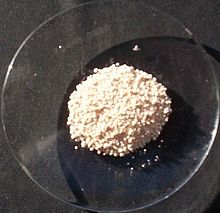Hafnium compounds
Hafnium compounds are compounds containing the element hafnium (Hf). Due to the lanthanide contraction, the ionic radius of hafnium(IV) (0.78 ångström) is almost the same as that of zirconium(IV) (0.79 angstroms).[1] Consequently, compounds of hafnium(IV) and zirconium(IV) have very similar chemical and physical properties.[1] Hafnium and zirconium tend to occur together in nature and the similarity of their ionic radii makes their chemical separation rather difficult. Hafnium tends to form inorganic compounds in the oxidation state of +4. Halogens react with it to form hafnium tetrahalides.[1] At higher temperatures, hafnium reacts with oxygen, nitrogen, carbon, boron, sulfur, and silicon.[1] Some compounds of hafnium in lower oxidation states are known.[2]
Halides
- By the reaction of
- HfO2 + 2 CCl4 → HfCl4 + 2 COCl2
- Chlorination of a mixture of HfO2 and
- HfO2 + 2 Cl2 + C → HfCl4 + CO2
- Chlorination of hafnium carbide above 250 °C.[9]
Hafnium(IV) chloride and hafnium(IV) iodide have some applications in the production and purification of hafnium metal. They are volatile solids with polymeric structures.
Hafnium does form lower halides such as hafnium(III) iodide. Hafnium trihalides are strongly reducing compounds and as such do not have any aqueous chemistry.[14]
Oxides

The white
Hafnium(IV) oxide typically adopts the same structure as zirconia (ZrO2). Unlike TiO2, which features six-coordinate Ti in all phases, zirconia and hafnia consist of seven-coordinate metal centres. A variety of other crystalline phases have been experimentally observed, including cubic fluorite (Fm3m), tetragonal (P42/nmc), monoclinic (P21/c) and orthorhombic (Pbca and Pnma).[16] It is also known that hafnia may adopt two other orthorhombic metastable phases (space group Pca21 and Pmn21) over a wide range of pressures and temperatures,[17] presumably being the sources of the ferroelectricity observed in thin films of hafnia.[18]
Thin films of hafnium oxides deposited by
Other compounds

- HfO2 + 3NaBH4 → HfB2 + 2Na(g,l) + NaBO2 + 6H2(g)
Hafnium disulfide is a layered dichalcogenide with the chemical formula of HfS2. A few atomic layers of this material can be exfoliated using the standard Scotch Tape technique (see graphene) and used for the fabrication of a field-effect transistor.[29] High-yield synthesis of HfS2 has also been demonstrated using liquid phase exfoliation, resulting in the production of stable few-layer HfS2 flakes.[30] Hafnium disulfide powder can be produced by reacting hydrogen sulfide and hafnium oxides at 500–1300 °C.[31]
See also
- Titanium compounds
- Zirconium compounds
- Lutetium compounds
- Tantalum compounds
- Lanthanide contraction
References
- ^ a b c d e "Los Alamos National Laboratory – Hafnium". Retrieved 2008-09-10.
- ISBN 978-0-08-037941-8.
- ISBN 1-4398-5511-0.
- .
- ^ Kirk-Othmer Encyclopedia of Chemical Technology. Vol. 11 (4th ed.). 1991.
- ISBN 9780470132357.
- ^ Hopkins, B. S. (1939). "13 Hafnium". Chapters in the chemistry of less familiar elements. Stipes Publishing. p. 7.
- ISBN 978-0080362397.
- ^ Elinson, S. V. and Petrov, K. I. (1969) Analytical Chemistry of the Elements: Zirconium and Hafnium. 11.
- ^ Berdonosov, S. S.; Berdonosova, D. G.; Lapitskii, A. V.; Vlasov, L. G. "X-ray study of hafnium tetrabromide" Zhurnal Neorganicheskoi Khimii, 1963, vol. 8, 531-2.
- ^ .
- ^ ISBN 978-3-11-007511-3.
- ISBN 978-0-08-037941-8.
- .
- .
- S2CID 53347579.
- .
- .
- .
- ^ Agte, C. & Alterthum, H. (1930). "Researches on Systems with Carbides at High Melting Point and Contributions to the Problem of Carbon Fusion". Z. Tech. Phys. 11: 182–191.
- .
- ISBN 1-4398-5511-0.
- .
- Sigma Aldrich. Retrieved 29 October 2021.
- ^ "Hafnium Nitrate". American Elements. Retrieved 29 October 2021.
- U.S. Atomic Energy Commission. 1960. p. 31. Retrieved 29 October 2021.
- S2CID 50290009.
- PMID 26926098.
- S2CID 99414438.
- S2CID 95277086.
